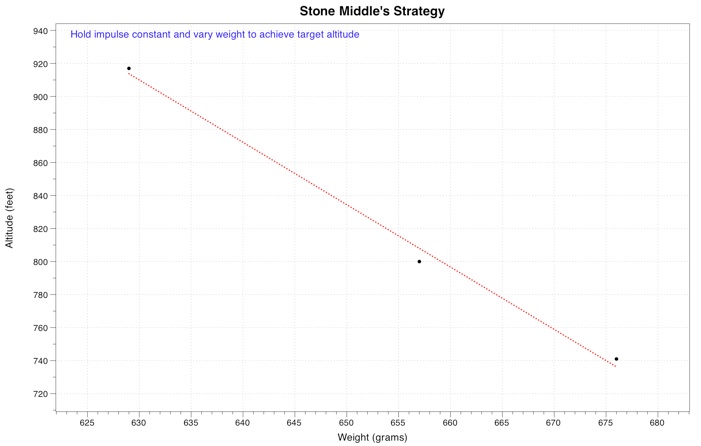 The 2009 TARC season is essentially over; all that’s left is the Nationals at Manassas on May 16, where once again Stone Middle will represent the state of Alabama. It’s a triumph for their team, who made good use of a simple, effective strategy.
The 2009 TARC season is essentially over; all that’s left is the Nationals at Manassas on May 16, where once again Stone Middle will represent the state of Alabama. It’s a triumph for their team, who made good use of a simple, effective strategy.
One much more effective than the one I employed this year. Being more complex, it led to the eventual destruction of my rocket and reminded this aging geezer of the value of the K.I.S.S. (Keep It Simple, Stupid) principle.
My approach this season was to achieve the target altitude by varying the total impulse of the rocket, holding weight roughly constant. So I constructed a rocket capable of handling up to a 5 motor cluster; by adding or taking away motors I figured it would make 750’ feet easily. Indeed, if you add up the impulses of the motors used in each flight, and plot this with peak altitude as measured by the altimeter, you get a graph like this:

However, 5 motors are awfully hard to light simultaneously with Estes igniters and a clip whip. 4 I could do consistently, but 5… Well, let’s just say when the core E9 doesn’t ignite, it’s going to be a bad day. However, the plot above does show that I would have come very near my mark had I gotten the E9, 2 C6’s, and 2 A10’s to pull together on lift off. This provides some small consolation as I stare at the pieces of my rocket sticking out of the garbage can.
Stone’s easier strategy – the one that got them to Nationals this year – was to reach 750 feet by varying the weight of the rocket and holding the impulse constant, which they achieved by using the same motor type from the same production run. After each flight, they plotted the altitude of of the rocket as recorded by the altimeter versus its lift off weight, measured just before flight with a postal scale. The graph looked something like:

Once they had made 3 or 4 flights, they had enough points to easily determine the amount of weight needed to reach the target altitude. Like I said, an effective strategy, and more importantly, a simple one. The K.I.S.S. principle has been vindicated once more.
So what are TARC 2009’s lessons? In my opinion, there are 6:
- Consistently attend the TARC classes offered by HARA.
- Use good construction techniques on your rocket; for example, avoid using super glue or tape to attach fins or launch lugs.
- Using the K.I.S.S. principle, come up with a strategy for achieving the contest goals. I focussed on the altitude here, but you also need one for the duration mark.
- Make several practice flights, enough to “dial in” the altitude and duration by adjusting some aspect(s) of the rocket.
- Don’t wait till the last week or two to start practicing.
And last, but not least…



Hello, I was reading your blog about the rocket launch in 2009 and I was wondering, do you know any rocket motor suppliers in Huntsville? I am from Prescott AZ and I am going to launch a rocket in NASA USLI project, however, I dont know where I can get this motors in Huntsville.
Thanks!